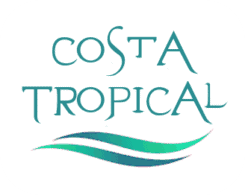- Home
- Listings
- Things To See & Do
- Car Hire
- News
- Properties
- What’s On
ES
Costa Tropical and Granada Museums
Local Art and Artifact Collections
Granada
La Alhambra Museum
Housed in the Palace of Carlos V, within the Alhambra, this museum contains outstanding Hispano-Moorish works of art from the 9th to the 16th centuries, including ceramics, wood, plaster, and metals. In addition, there is a section of Oriental Moorish art.
Minibus to the Alhambra from the Plaza Nueva.
Open: Summer (April 1st through October 14th): Wednesday to Saturday 8:30am to 8pm. Tuesday and Sunday 8:30am to 2:30pm. Winter (October15th through March 31st): Wednesday to Saturday 8:30am to 6pm. Admission is free. Telephone: 958 22 62 79. Visit website.
See also The Alhambra page.
Casa de los Pisa
This is where San Juan de Dios died in 1550. He was a guest of the aristocratic García de Pisa family. The mansion is now a museum and art gallery. The art gallery has an important collection of Flemish paintings, including works by Van Cleve and Gosart. The museum contains relics of the saint himself.
The building is located behind the Real Chancillería (High Court), just before entering Carrera del Darro, at the Plaza Nueva. It has a Gothic-style facade with the Orden de los Hermanos Hospitalarios coat-of-arms carved in stone. Inside, stairs from the Moorish-style courtyard lead to an attractive first-floor patio and chapel supported by columns from below.
The museum is open 10am – 2pm, Mon-Sat. Admission is 4 euros. Address: Museo de San Juan de Dios, Casa de los Pisa, Calle Convalencencia 1, Granada. Telephone: 958 222 144. Visit website.
Museum of Fine Arts
This museum in Granada preserves important works of art starting from the 16th century, including pieces by Alonso Cano and Machuca. Especially noteworthy is the sculpture El Entierro de Cristo (The Burial of Christ) by Jacobo Florentino. Other art objects from former convents and churches in Granada can also be admired. Palace of Carlos V. Alhambra. Microbus-Alhambra (C3). Open: Summer (April 1st through October 14th): Tuesday to Saturday 9am to 8pm. Sunday and bank holidays 9am to 3pm. Winter (October15th through March 31st): Tuesday to Saturday 9am to 6pm. Sunday and bank holidays 9am to 3pm. Admission is free for for EU nationals. Other countries: 1,5 euros.
Telephone: 958 22 48 43. Visit website.
Royal Chapel Museum
This Granada museum houses important works of great historical and artistic value, including the crown and scepter of Queen Isabella and a priceless collection of panels from the Flemish School, a gift from the Queen to Granada. Cathedral. Buses 3, 4 & 8.
Open: Monday to Saturday 10am to 6:30pm. Sunday 11am to 6:30pm. Admission is 6 euros. Buy your tickets online in their website.
Telephone: 958 22 78 48.
Archeological Museum
A collection of artifacts from prehistoric to Tartessian, Phoenician and Iberian cultures.
Carrera del Darro, 41.
Microbus-Albaicín. Open: Summer (June 16th through September 15th): Tuesday to Sunday 9am to 5pm. Winter (September 16th through June 15th): Tuesday to Saturday 9am to 9pm. Sunday and bank holidays 9am to 3pm. Admission is free for EU nationals, other countries 1,5 euros. Telephone: 958 034666. Visit website.
Granada Science Park
Almost 300 interactive exhibits involving electricity, light, sound, gravity. astronomy, meteorology and various other natural phenomena. Exhibits include a 50m observation tower, a planetarium, a house of tropical butterflies, a maze, watergardens, an astronomy garden and a 12-meter Foucault pendulum.
Tuesdays-Saturdays from 10am – 7pm. Sundays from 10am to 3pm. Free car park. Entrance fee: €7. Tel: +34 958 131 900 Email: web@parqueciencias.com. Visit website.
Casa-Museo de Manuel de Falla
The home of Spain’s most influential 20th century composer, Manuel de Falla, has been preserved exactly as it was when he lived there (from 1921 to 1939) – from his piano on which he composed his masterpieces right down to the dishes from which he ate his meals. Performances of the composer’s music are occasionally performed on the premises. Open: Winter (October through May): Tuesday to Saturday 10am to 5pm, Sundays 10am to 3pm. June and September: Tuesday to Sunday 9am to 2:30pm. July and August: Tuesday to Saturday 9am to 2:30pm. Closed on Monday, Sunday and bank holidays in July and August and on Monday and bank holiday the rest of the year. Admission fee is 3 euros. Address:
Museo Manuel de Falla, Paseo de los Mártires. Telephone: 649055947. Visit website.
Museo Caja Granada Memoria de Andalucia
A museum dedicated specifically to the history and culture of Andalusia. There are four main areas, each with a different theme. Area one is dedicated to geographical diversity. Area two is about land and cities. The third area deals with lifestyle. The fourth area is concerned with art and culture. The exhibit descriptions and videos are in Spanish and English.
Avenida de la Ciencia, 2, 18006 Granada. Tel: 958222257. Open: Summer (June 26th through September 10th): Monday to Friday 9:30am to 2pm. Closed on Saturday, Sunday and bank holidays. Winter (September 11th through June 25th): Tuesday, Wednesday and Thursday 9:30am to 2pm. Friday 9:30-2pm and 5pm-7pm. Saturdays 10:30am-2pm. Closed on Monday, Sunday and bank holidays. Visit website.
Carmen de los Geranios: Casa Museo Max Moreau
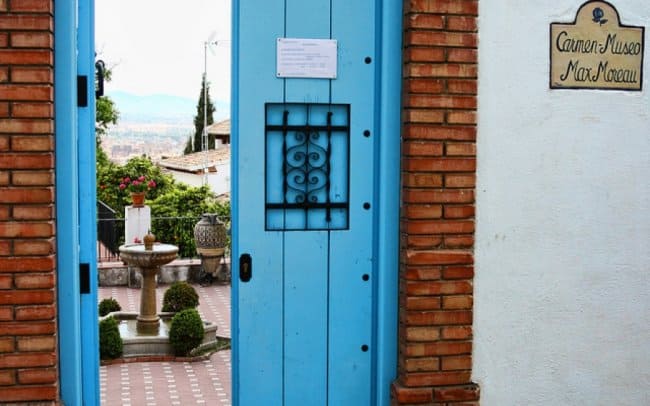
If you’re exploring the Albaicín neighborhood in Granada, be sure to visit the Max Moreau House Museum at Carmen de los Geranios, near the Mirador de San Nicolás. This charming municipal museum once served as the home of Belgian artist Max León Moreau, who, in his later years, donated his legacy to the city. The museum, housed in a traditional “Carmen” – a unique type of Andalusian house with gardens – offers a fascinating glimpse into Moreau’s artistic life and his connection to the city. The property, which combines a dwelling and terraced gardens, features a fig tree, rose bushes, geraniums, and a small pool, creating a serene atmosphere that blends nature with culture. Explore the museum’s three interconnected buildings: the exhibition hall showcasing Moreau’s works and those of guest artists, the artist’s personal library filled with his books and literary works, and his preserved studio, complete with personal mementos like his piano and oriental artifacts. Visiting this intimate space is a captivating journey through Moreau’s life and legacy in the heart of Granada.
Almuñécar
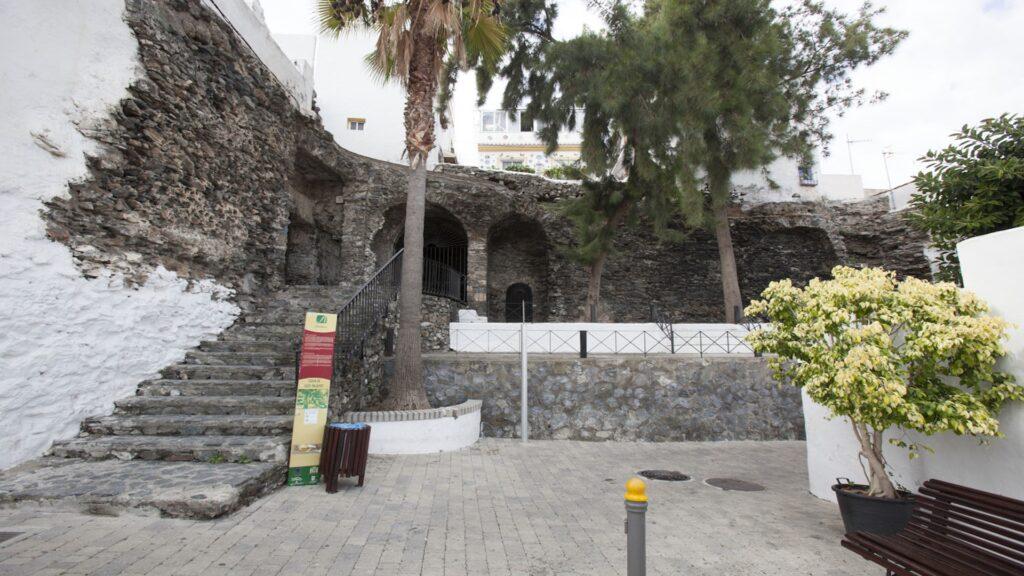
Cave of Seven Palaces Archeological Museum (Almuñécar)
The site of this museum was once the basement of a large Roman construction, possibly a temple to honour the goddess Minerva. In its interior, the visitor can admire some of the fascinating historical remains of Almuñcar, such as the collection of objects from the Necropolis of Puente de Loy and Laurita, and a seventeenth-century BC Egyptian vase sculpted from solid quartz.
Open: Summer (July 1st through September 15th): Tuesday to Saturday 10am to 1:30pm / 6:30pm to 9pm. Sunday 10am to 1pm. Spring and autumm (April 1st through June 30th and September 16th through October 30th): Tuesday to Saturday 10am to 1:30pm / 5pm to 7:30pm. Sunday 10am to 1pm. Winter: November 1st through March 31st: Tuesday to Saturday 10am to 1:30pm / 4pm to 6:30pm. Sunday 10am to 1pm. Closed all day Monday, and Sunday afternoon.
Address: Cueva de los Siete Palacios, calle Eras del Castillo 29, 18690, Almuñécar. Tel: 958 61 61 31. Email: culturalmunecar@almunecar.es.
Motril
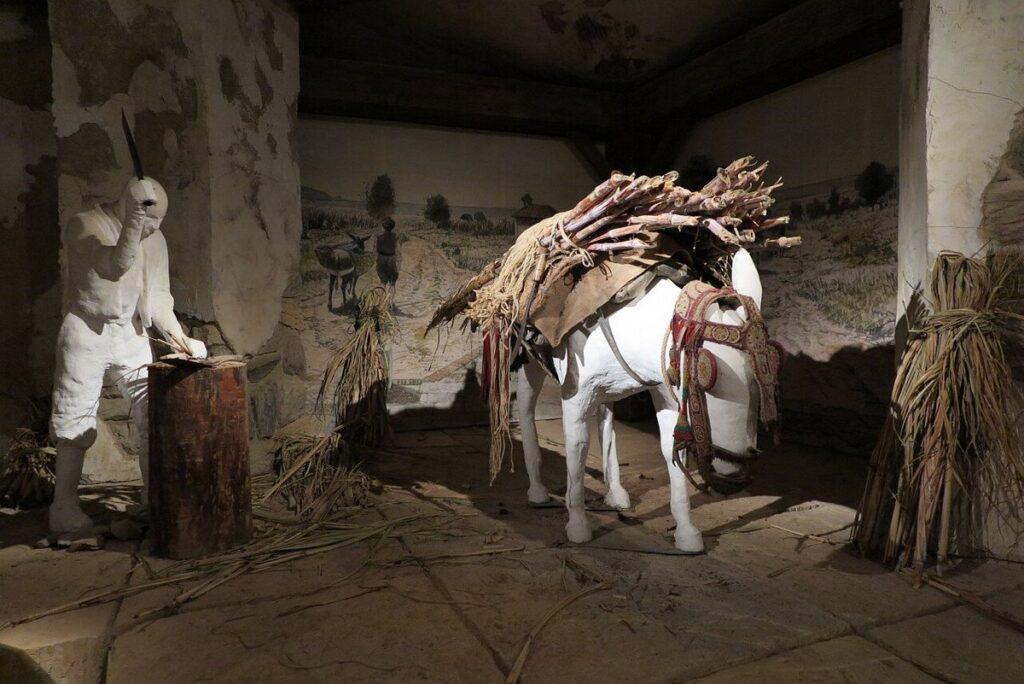
Museo Preindustrial de la Caña de Azúcar (Museum of Pre-industrial Sugar Cane)
The Sugar Cane Museum in Motril, takes visitors on a captivating journey through the history of sugar production and its impact on the region. Focusing on the processes of making and trading sugar from the 13th to 18th centuries, the museum features detailed miniature models of mills and presses that were central to sugar-making. It also recreates cooking and purifying rooms, offering a glimpse into the hard work involved.
What sets this museum apart is its educational experience, guiding visitors through almost a millennium of sugar cane culture. It showcases the evolution of techniques, technologies, and the cultural significance of sugar production. The museum’s dedication to history is seen through its possession of Europe’s oldest mill, reflecting its commitment to preserving the past.
Beyond artifacts, the museum highlights Motril’s global role in sugar cane production, emphasizing its historical, economic, and cultural significance. The museum provides a sensory journey, connecting visitors to the labor, innovation, and cultural value of sugar production.
Open: Summer (June 15th through September 15th): Tuesday to Thursday 10am to 2:30pm and 6pm to 8pm. Friday and Saturday: 10am to 2:30pm / 6pm to 8pm. Winter: September 16th through June 14th: 10am – 2pm / 4pm -7pm. Sunday 10am-2pm. Guided tour available in Spanish, English, French or German languages. Fee: 3 euros
Address: Museo del Azúcar de Motrol, calle Zafra, 6, 18600, Motril. Tel: 958 822 206. Email: museodelazucar@motril.es. Visit website.

Museo de Historia de Motril (Museum of History of Motril)
At the Museum of History of Motril (MHIMO), local history is told in a didactic and direct manner, using new audiovisual technologies. The visit to this historical 17th-century building, restored to house this museum, begins with the welcome of various characters from the history of Motril. On the first floor, it covers everything from prehistory to the first major cycle of sugar, including Muslim Motril, the conquered city, and the city’s struggle against pirate attacks. On the second floor, we find innovations in crops and the Enlightenment movement that influenced Motril society.
We can also discover the process of Enlightenment, the crisis in sugar production, and the civil war in Motril. The visit concludes with a tour of its more recent history.
Contact info
Location:C/ Cardenal Belluga 14, 18600 Motril
Email: museodehistoria@motril.es
Tel:958 603 224
Opening hours:
Tuesday to Thursday: 10:00 am to 2:00 pm.
Friday and Saturday: 10:00 am to 2:00 pm / 5:30 pm to 7:30 pm.
Sunday and Monday: Closed
Guides are available for visitors in various languages for self-guided tours.It also offers educational booklets for students at different educational levels, as well as answer guides for teachers. Information brochures about the museum are available in various languages. Access to the Temporary Exhibition Hall is free.
General Admission: €3
Reduced Admission: €2 (visitors under 35 years old, over 65 years old, groups of 20 people or more, Disabled individuals.
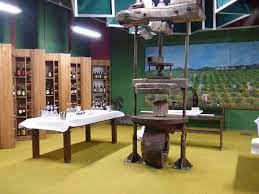
Museo del Aceite Andaluz
A unique place on the Costa Tropical where you can explore an ancient culture: that of olive oil. In Vélez de Benaudalla, the Andalusian Olive Oil Museum aims to promote agri-food products from Andalusia, with a primary focus on olive oil as a key element of its gastronomy. Get a firsthand look at the culture of olive oil on the Costa Tropical and its most renowned food products.
The museum features an exhibition area, an olive heritage zone, a conference room, a shop, and offices. Notable exhibits include a display of oils and a collection of antique machinery related to the world of olive farming and oil extraction.
You’ll have the opportunity to gain firsthand knowledge of one of the oldest and most significant economic cultures in Andalusia: how this vital product is born and obtained, and its collection of the main producing areas in the region.
The Olive Oil Museum is divided into an Exhibition Area, Heritage Zone, Conference Hall, Shop, and Office.
They organize tours in various languages, guided tours with breakfast or snacks, tours with an introduction to oil tasting, wine tastings, courses on ham cutting, meetings, conferences, and incentives for companies.
Contact info
Location: Carretera Bailén-Motril km 186.5 18670 Vélez de Benaudalla
Email: museoaceiteandaluz@gmail.com
Tel: 958 658 089 | Email:
Website: https://www.museodelaceiteandaluz.com/
Opening hours:
Winter: Monday to Friday, from 10:00am to 2:00 pm and from 4:00pm to 7:00pm. Saturday and Sunday, from 10:00am to 2:00pm.
Summer: Monday to Friday, from 10:00am to 2:00pm and from 5:00pm to 8:30 pm. Saturday, from 10:00am to 2:00pm.
General Admission: Free (self-guided access)
Guided visit: 8 euros per visitor. It includes olive oil tasting. It needs to be booked in advance.
Guided Picnic visit: 15 euros per visitor. It includes olive oil tasting. It needs to be booked in advance.
Gourmet Guided visit: 18 euros per visitor. It includes tasting of Andalusian olive oils, accompanied by a picnic of typical local products, such as locally grown fruits, figs, cured meats, cheese, jams, etc.. It needs to be booked in advance.
Federico Garcia Lorca Museums
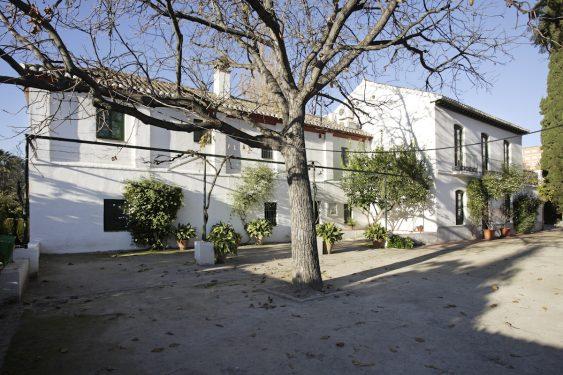
Huerta de San Vicente – Casa-Museo de Federico García Lorca
Federico García Lorca is one of Spain’s best-known and most loved writers. A poet and dramatist, he was also a skilled painter, pianist and composer. The Huerta de San Vicente is the summer house where Lorca penned a number of his most important works between 1926 and 1936, including The Gypsy Ballads and Blood Wedding (video clip), before he was killed by Nationalist partisans at the beginning of the Spanish Civil War. The house retains all its original furniture, and Lorca’s bedroom has been kept exactly as it was when he lived there. Open: Summer (June 1st through September 15th): Tuesday to Saturday 9am to 3pm with visits at 11, 11:30, 12, 12:30, 1 and 1:30pm. Winter: September 16th through May 31st (excluding Christmas and Easter): 10am – 5pm. Visits at 10:00,
10:45, 11:30, 12:15, 13:00, 13:45, 15:00, 15:45, 16:30. Christmas: Tuesday to Saturday 9am- 3pm. Easter: Tuesday, Wednesday and Saturday 9am to 3pm.
Address: Casa-Museo Federico García Lorca, calle Virgen Blanca, s/n, 18004 Granada. Tel: +34 958 258 466. Visit website.
Centro Federico García Lorca
The Federico García Lorca Center is a cultural institution focused on researching the life and work of the Granada poet and promoting his literary creations. Its main purpose is to safeguard the poet’s legacy under the García Lorca Foundation, led by his heirs. The center also serves as a venue for modern artistic events, featuring an auditorium, exhibition halls, offices, and a secure library for valuable materials.
Address: Plaza de la Romanilla, s/n 18001 Granada. Tel: (+34) 958 274 062. Exhibitions timetable: Summer (March 15th- September 14th): Tuesday to Saturday: 11am-2pm / 6pm-9pm. Winter: September 15th- March 14th: Tuesday to Saturday 11am-2pm / 5pm-8pm. Sunday and bank holidays: 11am-2pm. Closed on Monday. Email:
info@centrofedericogarcialorca.es. Visit website.
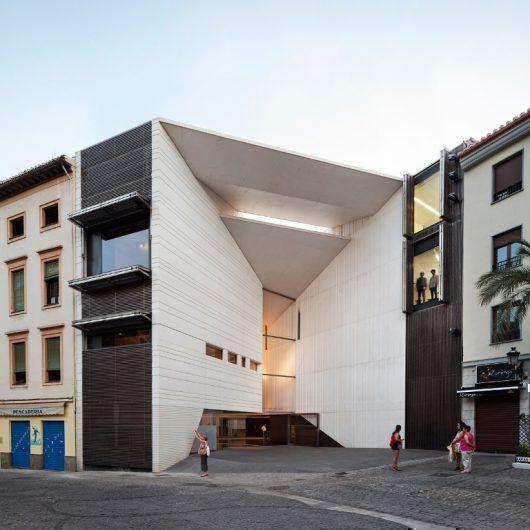
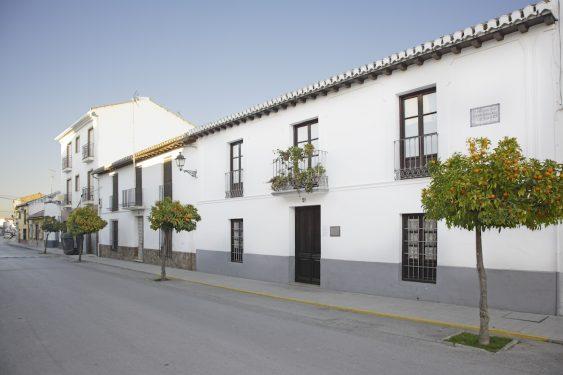
Federico García Lorca Birthplace in Fuentevaqueros
The birthplace of Federico García Lorca in Fuente Vaqueros has been restored by the Diputación de Granada and transformed into a museum. The museum’s rooms authentically recreate the ambiance of his youth through decor and furniture. The second floor, once a barn, now hosts exhibitions and cultural events. The museum holds numerous written and visual documents, as well as personal items and belongings connected to the poet’s life and work.
Built in 1880 during Federico García Rodríguez’s marriage to Matilde Palacios, the house exemplifies a typical farmhouse found in La Vega of Granada. It went through various changes with different families until its acquisition by the Diputación de Granada in 1982. With the formation of the Federico García Lorca Board, the house began functioning as a museum in 1986.
This house-museum is significant for preserving García Lorca’s memory and creating an emotionally charged space that nurtures his ideas and legacy. The museum offers a brief yet intense journey through time, exploring his personal spaces such as the dining room, kitchen, bedrooms, and patio. The converted barn serves as an exhibition hall, displaying his letters, drawings, books, and hidden secrets that unveil lesser-known aspects of his complex personality.
Check the schedules and book on their website. Address: Calle García Lorca 4, Fuentevaqueros, Granada. Visit website.
Casa Museo Federico García Lorca – Valderrubio
Federico García Lorca’s early years were spent in this Valderrubio house, which now functions as a local museum in his memory. The farmhouse has even maintained his room as per his request in a letter to his family.
Built in 1915 over the foundations of his father’s old house, this traditional two-story farmhouse served as both a residence and storage for harvested crops. During his time here, Federico attended school and experienced his first traveling theater. Until 1925, it was the family’s summer retreat as well.
The main house, originally intended for domestic use and crop storage, is accompanied by a smaller annex with a more humble design where the landlords lived. Both houses open onto a spacious, well-lit courtyard, containing additional structures like corrals and the former stable, now repurposed into a theater and temporary exhibition space.
The museum showcases personal items and furniture, some of which were preserved by neighbors responsible for looking after the house and cultivating the family’s lands. Check the schedules and book on their website. Address: Calle Iglesia, nº 20
Valderrubio, Granada. Visit website.
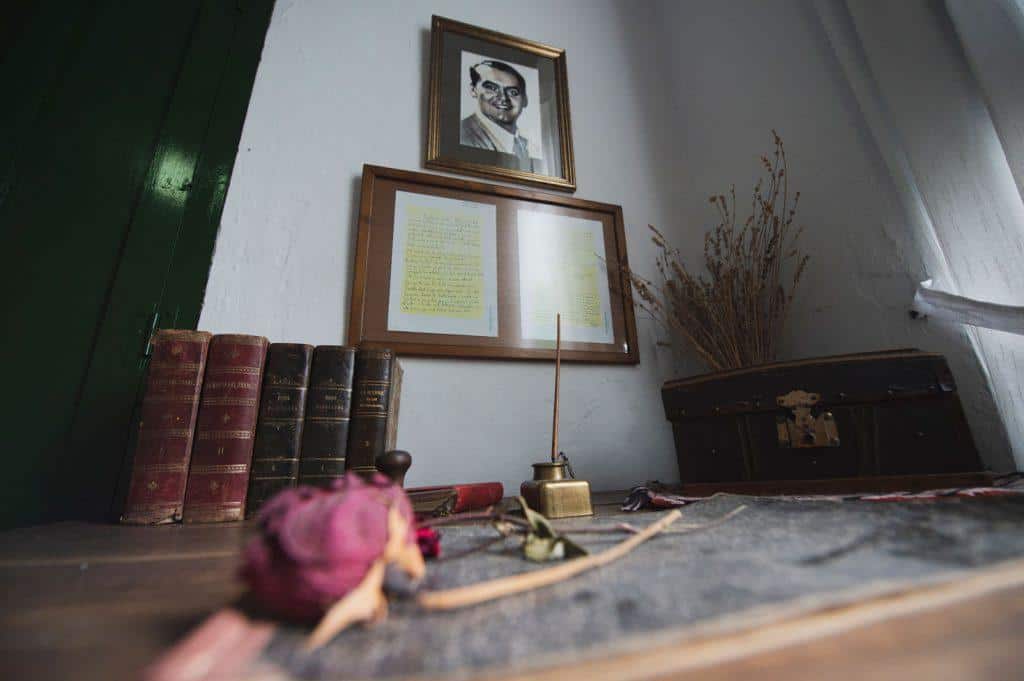
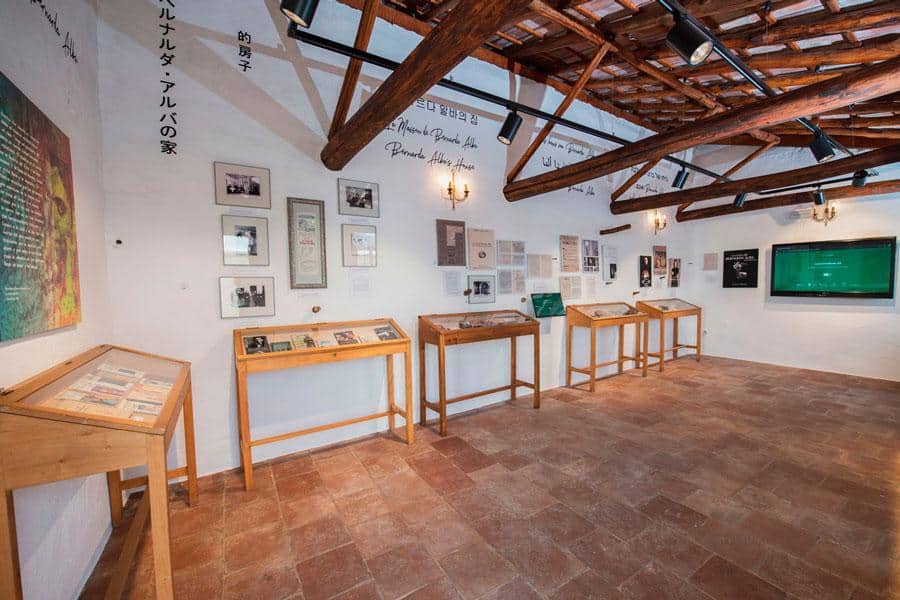
House of Bernarda Alba in Valderrubio
The House of Bernarda Alba, which served as Federico García Lorca’s inspiration for one of his renowned plays, became a museum in 2018. The house is situated also in Valderrubio in the heart of La Vega of Granada.
This traditional two-story farmhouse, designed for both living and storing crops, has a spacious courtyard that offers numerous possibilities for organizing cultural events.
The objective of the project was to transform the house into a tourist and cultural space accessible to the public. This space aims to showcase Lorca’s significance in the world of theater and highlight Valderrubio as a wellspring of inspiration.
Visitors are treated to a multimedia and audiovisual recreation of the ambiance, traditions, and experiences that fueled the poet and playwright’s work. This immersive experience allows emotions to transport visitors back to the time of the play, as the building has preserved its scenes in their original state.
Check the schedules and book on their website.
Address: Calle Real de Valderrubio, nº 1
Valderrubio, Granada. Visit website.
